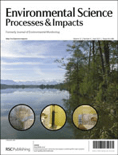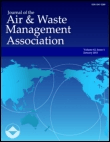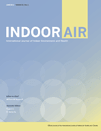
Atmospheric Pollution Research
Scope & Guideline
Advancing knowledge for cleaner skies.
Introduction
Aims and Scopes
- Air Quality Monitoring and Assessment:
The journal emphasizes the development and validation of methods for monitoring air quality, including the use of low-cost sensors, satellite data, and advanced modeling techniques. - Source Apportionment Studies:
Research often includes identifying and quantifying the sources of air pollutants, such as particulate matter (PM2.5, PM10), volatile organic compounds (VOCs), and heavy metals, using various methodologies like positive matrix factorization and chemical speciation. - Health Risk Assessment:
A significant focus is placed on assessing the health risks associated with exposure to air pollutants, including respiratory diseases, cardiovascular conditions, and other health impacts. - Impact of Meteorological Factors:
The journal also explores the influence of meteorological conditions on air quality, including studies on how weather patterns affect pollutant dispersion and concentration. - Policy and Regulation Impacts:
Research often evaluates the effectiveness of environmental policies and regulations on air quality improvements and the implications for public health. - Emerging Pollutants and Environmental Concerns:
The journal addresses contemporary issues such as the impact of microplastics, persistent organic pollutants, and the effects of climate change on air quality.
Trending and Emerging
- Machine Learning and AI in Air Quality Prediction:
The increasing application of machine learning and artificial intelligence techniques for predicting air quality and pollutant concentrations is a notable trend, reflecting advancements in computational capabilities. - Health Impacts of Air Pollution:
There is an enhanced focus on the health impacts of air pollution, particularly studies linking particulate matter exposure to respiratory and cardiovascular diseases, indicating a growing concern for public health. - Urban Air Quality Management:
Research addressing urban air quality issues, including the effects of urban planning and green infrastructure on pollution levels, is gaining traction as cities seek sustainable solutions to air quality challenges. - Transboundary Pollution Studies:
Emerging themes include investigations into transboundary air pollution, highlighting the interconnectedness of air quality issues across regions and the need for collaborative solutions. - Climate Change Interactions with Air Quality:
Research exploring the intersection of climate change and air quality, including how changing climatic conditions affect pollutant levels and health outcomes, is increasingly relevant. - Innovative Monitoring Technologies:
The development of new monitoring technologies, including drones and advanced sensor networks, is an emerging focus, facilitating more precise and comprehensive air quality assessments.
Declining or Waning
- Traditional Industrial Emissions:
Research focusing solely on emissions from traditional industrial sources, such as coal-fired power plants, has become less frequent as studies increasingly incorporate diverse and emerging sources of pollution. - Non-Health-Related Environmental Impact Studies:
There is a noticeable decrease in studies that solely focus on non-health-related environmental impacts of air pollution, as the journal shifts towards a more health-centric approach. - Static Air Quality Models:
The use of static models that do not incorporate real-time data or advanced machine learning techniques is waning, with a clear trend towards dynamic and predictive modeling approaches.
Similar Journals

ATMOSFERA
Bridging Research and Environmental UnderstandingATMOSFERA is a prestigious journal published by CENTRO CIENCIAS ATMOSFERA UNAM, dedicated to advancing the field of Atmospheric Science. With an ISSN of 0187-6236 and an E-ISSN of 2395-8812, this bilingual journal has been a vital resource for researchers since its inception in 1988. Located in Mexico City, the journal serves as a platform for high-quality original research, reviews, and case studies that explore various atmospheric phenomena, climate issues, and environmental challenges. Although currently categorized in the Q4 quartile of Atmospheric Science, ATMOSFERA aims to contribute to the growing body of knowledge in the field and improve its ranking over the next few years, emphasizing rigorous scientific inquiry and fostering collaboration among scholars. Its accessibility and commitment to open communication make it an essential reference for professionals and students striving to understand and address complex atmospheric dynamics.

Journal of Meteorological Research
Bridging Knowledge in Meteorology and Ocean Engineering.The Journal of Meteorological Research, published by SPRINGER HEIDELBERG, stands as a vital resource in the fields of Atmospheric Science and Ocean Engineering, boasting an impressive impact factor that reflects its scholarly significance. With its ISSN 2095-6037 and E-ISSN 2198-0934, the journal offers an open access platform, fostering accessibility and dissemination of cutting-edge research. Established in 2014 and running through to 2024, it is particularly distinguished in 2023 as Q2 in Atmospheric Science and Q1 in Ocean Engineering, underscoring its important contributions to these disciplines, with remarkable rankings in Scopus that place it in the top tiers of both categories. The journal accepts a broad range of research articles, reviews, and innovative methodologies, catering to a diverse audience of researchers, professionals, and students eager to advance their knowledge and expertise in meteorological studies. This makes the Journal of Meteorological Research an essential platform for anyone engaged in understanding and addressing the complex challenges of our changing climate.

Environmental Science-Processes & Impacts
Exploring the nexus of science and environmental impact.Environmental Science-Processes & Impacts is a premier journal published by the Royal Society of Chemistry, focusing on critical research in the field of environmental science. With ISSN 2050-7887 and E-ISSN 2050-7895, this journal has established itself as an authoritative source of knowledge since its inception in 2012, maintaining a remarkable Q1 quartile ranking across significant categories such as Environmental Chemistry, Management, Monitoring, Policy and Law, Medicine, and Public Health for the year 2023. It stands as an essential resource for professionals, researchers, and students, aimed at advancing scientific understanding and solutions to pressing environmental issues. With impressive ranks in Scopus, including #45 in Public Health and #27 in Environmental Chemistry, the journal provides a platform for impactful research and interdisciplinary collaboration, emphasizing open access to foster the dissemination of knowledge globally. Join a community committed to exploring the interconnectedness of environmental processes and their implications for society by contributing to or learning from cutting-edge studies published in this esteemed journal.

JOURNAL OF THE AIR & WASTE MANAGEMENT ASSOCIATION
Pioneering Research in Air Quality and Waste ManagementJOURNAL OF THE AIR & WASTE MANAGEMENT ASSOCIATION is a leading publication in the fields of environmental science, pollution control, and waste management, published by Taylor & Francis Inc in the United Kingdom. With an impressive history of publication dating back to 1989 and a commitment to advancing knowledge and practice in these critical areas, this journal serves as a valuable resource for researchers, professionals, and students alike. It holds a 2023 impact factor reflected through its competitive rankings in four distinct categories: Q3 in Atmospheric Science and Q2 in Management, Monitoring, Policy and Law, Pollution, and Waste Management and Disposal. The journal's dedication to disseminating innovative research and best practices plays a vital role in enhancing environmental policies and strategies globally. Although not currently Open Access, the journal is accessible through its ISSN 1096-2247 and E-ISSN 2162-2906, providing opportunities for rich academic discussion and collaboration in addressing pressing environmental challenges.

ENVIRONMENTAL SCIENCE & TECHNOLOGY
Empowering researchers to shape the future of environmental science.ENVIRONMENTAL SCIENCE & TECHNOLOGY, published by the American Chemical Society, is a premier journal dedicated to the rapid dissemination of innovative and impactful research in the fields of environmental science and technology. With an ISSN of 0013-936X and an E-ISSN of 1520-5851, this journal boasts a remarkable Q1 ranking across multiple categories including Chemistry (Miscellaneous), Environmental Chemistry, and Medicine (Miscellaneous) for 2023, reflecting its crucial role in advancing interdisciplinary approaches to pressing environmental issues. Notably, it holds prestigious Scopus rankings, being ranked #26 in General Chemistry and #10 in Environmental Chemistry, placing it in the top portions of its respective categories with unmatched visibility at the 93rd percentile. Spanning a publication history from 1967 to 2024, the journal serves as a vital resource for researchers, professionals, and students aiming to contribute to sustainable solutions and scientific advancements. By prioritizing rigor and relevance, ENVIRONMENTAL SCIENCE & TECHNOLOGY fosters academic dialogue and innovation within these crucial fields, making it an essential read for anyone invested in environmental progress.

Atmospheric Environment-X
Championing open access to vital atmospheric research.Atmospheric Environment-X, published by Elsevier Science Ltd, is a premier, open-access journal dedicated to advancing our understanding of atmospheric science and environmental disciplines. Since its inception in 2019, the journal has established itself as a critical platform for disseminating high-quality research, evident by its impressive Scopus rankings—39th out of 233 in General Environmental Science and 27th out of 148 in Atmospheric Science, placing it within the top quartiles of its fields. Operating from the United Kingdom, Atmospheric Environment-X aims to bridge the gap between fundamental research and practical applications, addressing pressing issues related to air quality, climate change, and environmental sustainability. With its commitment to open access, the journal encourages broad accessibility of knowledge, ensuring that cutting-edge research reaches a global audience of researchers, professionals, and students eager to contribute to the field. Join us as we explore the complexities of our atmosphere and its critical interactions with the environment through groundbreaking studies published up to 2024.

AEROSOL SCIENCE AND TECHNOLOGY
Unveiling the Complexities of Aerosol InteractionsAerosol Science and Technology is a premier academic journal dedicated to the study of aerosols, their properties, and their interactions with the environment, published by Taylor & Francis Inc. Since its inception in 1981, the journal has established itself as a leading source of research, boasting a commendable impact factor which underscores its relevance and influence in the fields of Environmental Chemistry, Materials Science, and Pollution, consistently ranking in the Q2 Quartile. With its comprehensive coverage of the latest advancements and interdisciplinary approaches, the journal serves as an essential resource for researchers, professionals, and students who seek to deepen their understanding of aerosol science and its applications. Although it does not currently offer Open Access options, its rigorous peer-review process ensures the publication of high-quality research that contributes significantly to both theoretical and practical advancements in the field. Readers will benefit from the journal's insightful articles that explore the complexities of aerosols and their impact on climate change, air quality, and health outcomes, making it a pivotal platform for disseminating cutting-edge findings up until 2024.

Air Quality Atmosphere and Health
Connecting Air Quality Insights to Public Health SolutionsAir Quality, Atmosphere and Health is a leading interdisciplinary journal published by Springer, focusing on the intricate relationship between air quality and public health. With roots dating back to 2008, the journal has established itself as a pivotal resource for researchers and professionals in the fields of Atmospheric Science, Health, Toxicology and Mutagenesis, and Pollution Management and Policy, achieving a commendable Q2 ranking across multiple categories in 2023. The journal’s rigorous peer-review process ensures that it publishes high-quality research that addresses contemporary challenges in air quality management and its impact on health outcomes. With no Open Access option, the journal maintains a model that prioritizes valuable insights for subscription holders, making it an essential reference point for advancing knowledge on environmental health issues. The journal is based in the Netherlands and contributes significantly to the understanding of atmospheric pollutants and their effects, evidenced by its strong Scopus rankings, positioning it in the top percentiles of various environmental science categories.

Asia-Pacific Journal of Atmospheric Sciences
Exploring the Frontiers of Atmospheric ScienceWelcome to the Asia-Pacific Journal of Atmospheric Sciences, a leading publication in the field of atmospheric science, published by the Korean Meteorological Society. With an ISSN of 1976-7633 and an E-ISSN of 1976-7951, this journal has been a cornerstone for researchers and practitioners in the atmospheric sciences since its inception in 2008. Recognized for its rigorous peer-reviewed articles, it holds a commendable Q2 quartile ranking in 2023 and is placed at the 51st rank out of 148 in the Earth and Planetary Sciences, reflecting its impact within the community with a 65th percentile. The journal features a broad scope encompassing meteorology, climatology, and environmental sciences, making it an essential resource for scholars and industry experts alike. As an open access journal, it ensures that groundbreaking research is widely accessible, fostering collaboration and innovation across the Asia-Pacific region and beyond. Explore the latest findings and advancements in atmospheric sciences and contribute to the dynamic field of climate research through the journal's engaging content.

INDOOR AIR
Transforming Spaces, Enhancing Lives.INDOOR AIR is a leading peer-reviewed journal published by WILEY-HINDAWI, focusing on the critical field of indoor environmental quality and its impact on public health. Since its inception in 1991, this esteemed journal has been at the forefront of research in Building and Construction, Environmental Engineering, and Public Health. With a commendable Q1 ranking across these categories in 2023, INDOOR AIR has established itself as a pivotal resource for scholars and industry professionals alike, as evidenced by its impressive Scopus rankings—35th in Public Health, 14th in Building and Construction, and 20th in Environmental Engineering. The journal is dedicated to disseminating groundbreaking research, reviews, and case studies that advance knowledge and methodologies in improving indoor air quality and its implications for health outcomes. Aspiring to maintain open access to vital scientific discourse, INDOOR AIR invites contributions that foster interdisciplinary collaboration and innovation in understanding indoor environments. Based in Denmark, the journal continues to engage a global audience committed to enhancing health and well-being through improved indoor air quality.